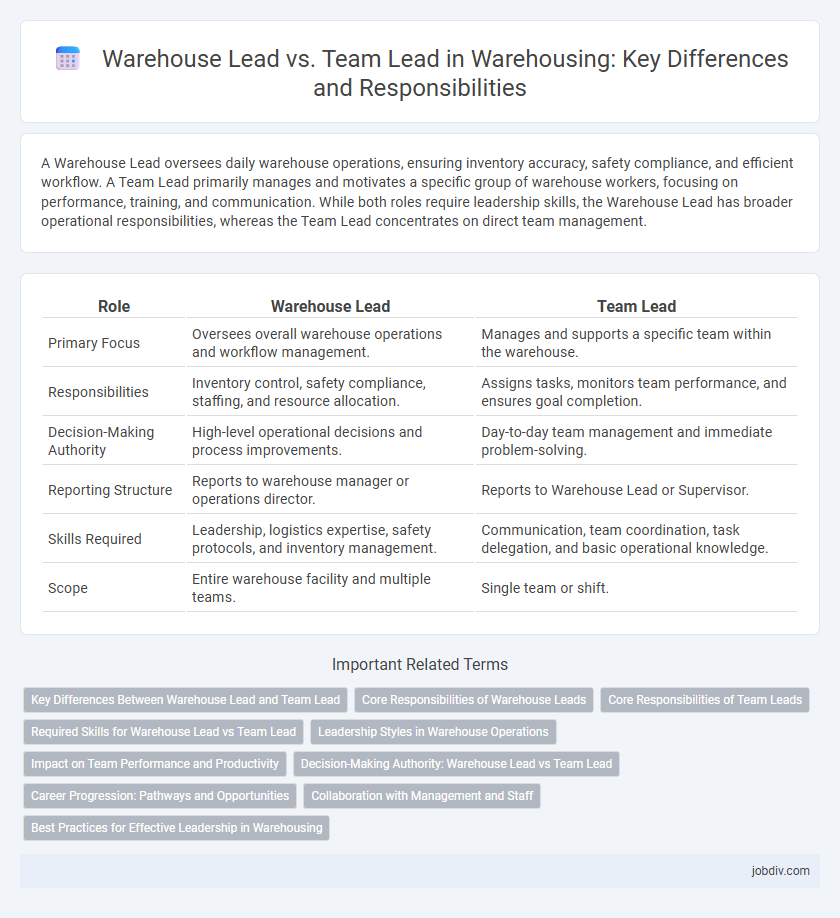A Warehouse Lead oversees daily warehouse operations, ensuring inventory accuracy, safety compliance, and efficient workflow. A Team Lead primarily manages and motivates a specific group of warehouse workers, focusing on performance, training, and communication. While both roles require leadership skills, the Warehouse Lead has broader operational responsibilities, whereas the Team Lead concentrates on direct team management.
Table of Comparison
| Role | Warehouse Lead | Team Lead |
|---|---|---|
| Primary Focus | Oversees overall warehouse operations and workflow management. | Manages and supports a specific team within the warehouse. |
| Responsibilities | Inventory control, safety compliance, staffing, and resource allocation. | Assigns tasks, monitors team performance, and ensures goal completion. |
| Decision-Making Authority | High-level operational decisions and process improvements. | Day-to-day team management and immediate problem-solving. |
| Reporting Structure | Reports to warehouse manager or operations director. | Reports to Warehouse Lead or Supervisor. |
| Skills Required | Leadership, logistics expertise, safety protocols, and inventory management. | Communication, team coordination, task delegation, and basic operational knowledge. |
| Scope | Entire warehouse facility and multiple teams. | Single team or shift. |
Key Differences Between Warehouse Lead and Team Lead
Warehouse Leads oversee inventory accuracy, order fulfillment, and equipment maintenance, ensuring smooth warehouse operations. Team Leads focus on supervising staff performance, coordinating daily tasks, and fostering team communication to meet productivity goals. The key difference lies in the Warehouse Lead's operational management versus the Team Lead's personnel and task coordination responsibilities.
Core Responsibilities of Warehouse Leads
Warehouse Leads oversee daily operations, ensuring efficient inventory management, order fulfillment, and adherence to safety protocols. They coordinate workflow, monitor performance metrics, and facilitate communication between warehouse staff and management to optimize productivity. Team Leads focus more on direct supervision and motivation of team members, whereas Warehouse Leads have broader responsibilities including strategic planning and resource allocation.
Core Responsibilities of Team Leads
Team Leads in warehousing primarily oversee daily operations, ensuring accurate order fulfillment, inventory management, and adherence to safety protocols. They coordinate between warehouse staff and management, providing clear communication and training to enhance workforce productivity. Team Leads also monitor performance metrics, address workflow bottlenecks, and implement process improvements to optimize warehouse efficiency.
Required Skills for Warehouse Lead vs Team Lead
Warehouse Lead requires strong expertise in inventory management, logistics coordination, and safety compliance, alongside the ability to operate warehouse management systems (WMS). Team Lead emphasizes leadership capabilities, effective communication, and conflict resolution to motivate and manage warehouse staff efficiently. Both roles demand organizational skills and problem-solving abilities, but Warehouse Lead leans more towards technical warehouse operations, while Team Lead focuses on team performance and personnel management.
Leadership Styles in Warehouse Operations
Warehouse Leads prioritize task-oriented leadership, ensuring operational efficiency and strict adherence to safety protocols in warehouse operations. Team Leads emphasize a people-centered leadership style, fostering communication, motivation, and collaboration among warehouse staff to enhance team performance. Both roles require a balance of these leadership styles to optimize workflow, employee engagement, and productivity in dynamic warehouse environments.
Impact on Team Performance and Productivity
Warehouse Leads directly influence team performance by coordinating daily operations, ensuring task completion, and maintaining workflow efficiency. Team Leads focus on motivating and guiding employees, resolving conflicts, and fostering collaboration, which enhances overall productivity and morale. Effective communication and leadership from both roles drive optimized warehouse output and operational success.
Decision-Making Authority: Warehouse Lead vs Team Lead
Warehouse Leads hold greater decision-making authority, overseeing inventory management, logistics coordination, and operational efficiency within the warehouse. Team Leads primarily focus on supervising daily tasks, ensuring workforce productivity, and addressing immediate operational issues without making high-level strategic decisions. The Warehouse Lead's role encompasses broader responsibilities, including policy implementation and resource allocation, distinguishing it from the Team Lead's more task-oriented leadership.
Career Progression: Pathways and Opportunities
Warehouse Lead roles emphasize operational efficiency and inventory management, serving as a foundational step for professionals aiming to deepen expertise in warehouse logistics. Team Lead positions build on this by incorporating leadership skills, team coordination, and strategic planning, offering pathways into supervisory or management careers. Career progression often advances from Warehouse Lead to Team Lead, then to roles such as Warehouse Supervisor or Operations Manager, highlighting opportunities for skill diversification and increased responsibility.
Collaboration with Management and Staff
A Warehouse Lead coordinates daily operations by collaborating closely with both management and warehouse staff to ensure efficient workflow and adherence to safety protocols. The Team Lead focuses on direct supervision of team members, fostering communication and resolving issues to maintain productivity and morale. Effective collaboration between these roles ensures alignment with organizational goals and smooth execution of warehouse tasks.
Best Practices for Effective Leadership in Warehousing
Warehouse Leads prioritize operational efficiency by closely monitoring inventory flow, ensuring accurate order fulfillment, and maintaining safety standards. Team Leads excel in fostering strong communication, motivating staff, and resolving conflicts to boost team performance and collaboration. Implementing clear role definitions, regular training, and performance feedback enhances leadership effectiveness and warehouse productivity.
Warehouse Lead vs Team Lead Infographic

 jobdiv.com
jobdiv.com